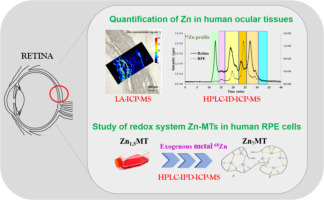Talanta ( IF 5.6 ) Pub Date : 2017-09-13 , DOI: 10.1016/j.talanta.2017.09.024 Sara Rodríguez-Menéndez , Beatriz Fernández , Montserrat García , Lydia Álvarez , Maria Luisa Fernández , Alfredo Sanz-Medel , Miguel Coca-Prados , Rosario Pereiro , Héctor González-Iglesias

|
The retina contains the highest concentration of zinc in the human eye and it is primarily associated with the retinal pigment epithelium (RPE). Metallothioneins (MTs) are the main cytosolic zinc-ion-binding proteins, exerting a tight control in the number of atoms of Zn-bound to the MTs related with their antioxidant and neuroprotective functions. In order to study the Zn-MT system in retina and RPE, we have implemented mass spectrometry (MS)-based technologies: two complementary element detection methodologies (HPLC- and laser ablation (LA)-ICP-MS) have been successfully employed to study metal content in the human eye as well as to perform speciation studies of Zn-MTs. First, Zn-elemental distribution was studied on cryogenic ocular sections by LA-ICP-MS. Quantitative images of Zn along RPE cell layer and the retina were obtained with a laser beam diameter of 25 µm, showing a preferential distribution in the RPE. We carried out then the quantitative speciation of Zn, Fe, and Cu in the water-soluble protein fractions of RPE and retina to study their protein binding profile using HPLC-ICP-MS, where Zn is mainly associated to low molecular mass proteins (i.e., MTs). Finally, the effect of addition of different inductors, such as metal (i.e., 68ZnSO4), dexamethasone (DEX) and erythropoietin, was investigated in an in vitro cellular model of human RPE cells (HRPEsv), again using HPLC-ICP-MS in combination with stable isotopes and mathematical calculations based on isotope dilution and isotope pattern deconvolution. Exogenous Zn and DEX were found to increase MT proteins synthesis and exerted a stoichiometric transition in MT proteins in HRPEsv cells.
中文翻译:

基于质谱的方法对人视网膜和RPE细胞中锌和金属硫蛋白的定量研究
视网膜在人眼中锌含量最高,并且主要与视网膜色素上皮(RPE)相关。金属硫蛋白(MTs)是主要的胞质锌离子结合蛋白,与MTs结合的锌原子数与其抗氧化剂和神经保护功能有关,因此受到严格控制。为了研究视网膜和RPE中的Zn-MT系统,我们已经实施了基于质谱(MS)的技术:两种互补元素检测方法(HPLC和激光消融(LA)-ICP-MS)已成功用于研究人眼中的金属含量以及进行Zn-MTs的形态研究。首先,通过LA-ICP-MS研究了低温眼部切片中的锌元素分布。沿RPE细胞层和视网膜的Zn定量图像是用直径为25 µm的激光束获得的,显示了RPE中的优先分布。然后,我们使用HPLC-ICP-MS对RPE和视网膜的水溶性蛋白组分中的Zn,Fe和Cu进行了定量分析,以研究它们的蛋白结合特性,其中Zn主要与低分子量蛋白(即,MTs)。最后,添加不同电感器(例如金属)的效果(即,在人RPE细胞(HRPEsv)的体外细胞模型中研究了68 ZnSO 4),地塞米松(DEX)和促红细胞生成素,再次使用HPLC-ICP-MS与稳定同位素结合并基于同位素稀释和同位素模式进行数学计算去卷积。发现外源Zn和DEX增加了HRPEsv细胞中MT蛋白的合成并在MT蛋白中发生了化学计量的转变。











































 京公网安备 11010802027423号
京公网安备 11010802027423号